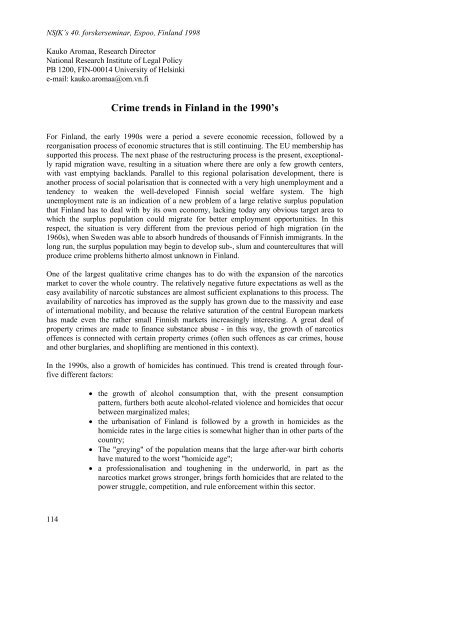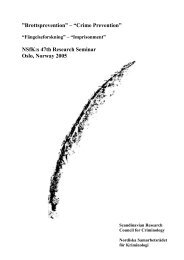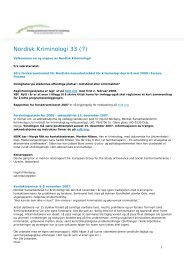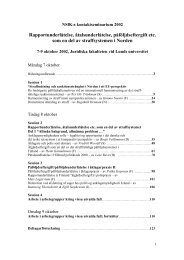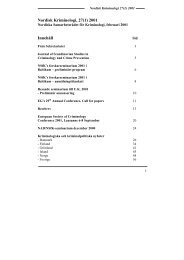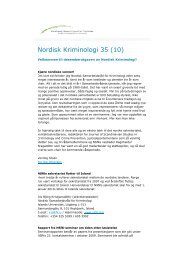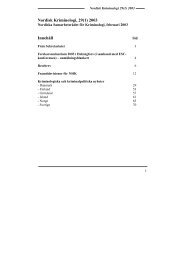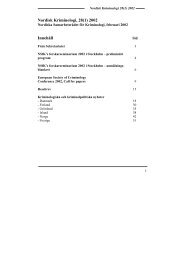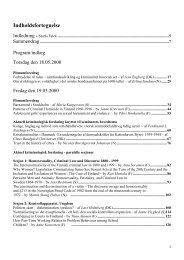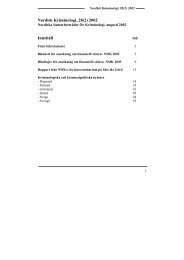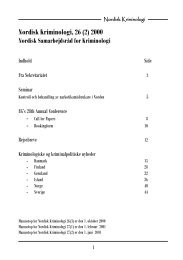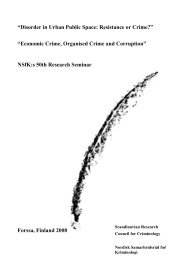Organised Crime & Crime Prevention - what works? - Scandinavian ...
Organised Crime & Crime Prevention - what works? - Scandinavian ...
Organised Crime & Crime Prevention - what works? - Scandinavian ...
You also want an ePaper? Increase the reach of your titles
YUMPU automatically turns print PDFs into web optimized ePapers that Google loves.
NSfK’s 40. forskerseminar, Espoo, Finland 1998<br />
Kauko Aromaa, Research Director<br />
National Research Institute of Legal Policy<br />
PB 1200, FIN-00014 University of Helsinki<br />
e-mail: kauko.aromaa@om.vn.fi<br />
114<br />
<strong>Crime</strong> trends in Finland in the 1990’s<br />
For Finland, the early 1990s were a period a severe economic recession, followed by a<br />
reorganisation process of economic structures that is still continuing. The EU membership has<br />
supported this process. The next phase of the restructuring process is the present, exceptionally<br />
rapid migration wave, resulting in a situation where there are only a few growth centers,<br />
with vast emptying backlands. Parallel to this regional polarisation development, there is<br />
another process of social polarisation that is connected with a very high unemployment and a<br />
tendency to weaken the well-developed Finnish social welfare system. The high<br />
unemployment rate is an indication of a new problem of a large relative surplus population<br />
that Finland has to deal with by its own economy, lacking today any obvious target area to<br />
which the surplus population could migrate for better employment opportunities. In this<br />
respect, the situation is very different from the previous period of high migration (in the<br />
1960s), when Sweden was able to absorb hundreds of thousands of Finnish immigrants. In the<br />
long run, the surplus population may begin to develop sub-, slum and countercultures that will<br />
produce crime problems hitherto almost unknown in Finland.<br />
One of the largest qualitative crime changes has to do with the expansion of the narcotics<br />
market to cover the whole country. The relatively negative future expectations as well as the<br />
easy availability of narcotic substances are almost sufficient explanations to this process. The<br />
availability of narcotics has improved as the supply has grown due to the massivity and ease<br />
of international mobility, and because the relative saturation of the central European markets<br />
has made even the rather small Finnish markets increasingly interesting. A great deal of<br />
property crimes are made to finance substance abuse - in this way, the growth of narcotics<br />
offences is connected with certain property crimes (often such offences as car crimes, house<br />
and other burglaries, and shoplifting are mentioned in this context).<br />
In the 1990s, also a growth of homicides has continued. This trend is created through fourfive<br />
different factors:<br />
• the growth of alcohol consumption that, with the present consumption<br />
pattern, furthers both acute alcohol-related violence and homicides that occur<br />
between marginalized males;<br />
• the urbanisation of Finland is followed by a growth in homicides as the<br />
homicide rates in the large cities is some<strong>what</strong> higher than in other parts of the<br />
country;<br />
• The "greying" of the population means that the large after-war birth cohorts<br />
have matured to the worst "homicide age";<br />
• a professionalisation and toughening in the underworld, in part as the<br />
narcotics market grows stronger, brings forth homicides that are related to the<br />
power struggle, competition, and rule enforcement within this sector.


